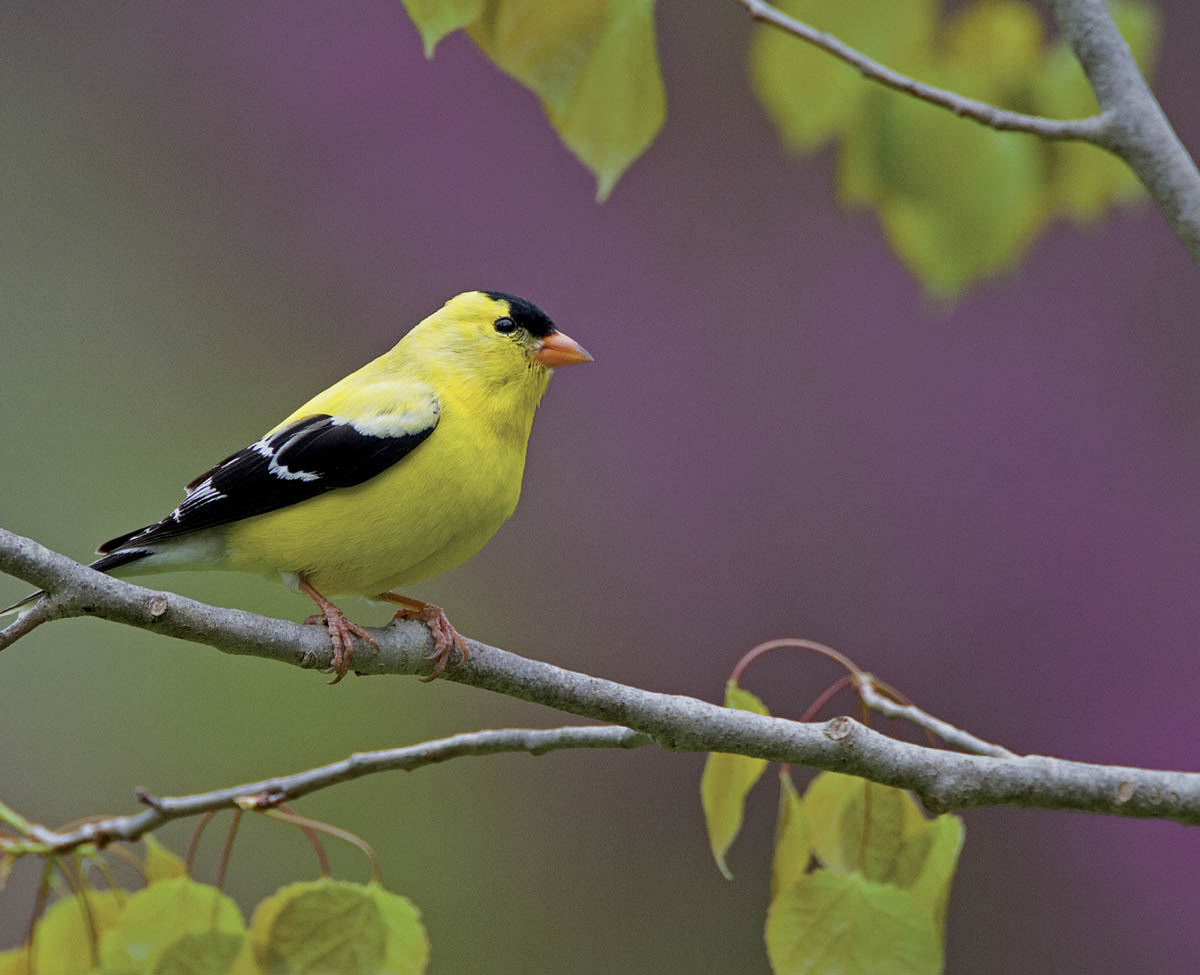
American Goldfinch male
The American Goldfinch is as close to a vegan as any in the world of birds. Throughout the year, goldfinches eat seeds, especially long, delicate ones like those of milkweed and thistle. At feeders, they’re especially drawn to nyger or niger (sometimes called thistle), but they’re perfectly capable of eating sunflower seeds. Most songbirds feed their young an insect diet, but goldfinch nestlings can thrive on nothing but seeds.

American Goldfinch male
Extremely sociable, goldfinches spend much of the year in flocks, and their pair bonds are fluid. Females may mate with more than one male, especially when re-nesting after a nest fails, and even when they successfully raise young together, they are unlikely to select the same male the following year. This may be because males outnumber females, with about eight male goldfinches for every five females. At the time of hatching, the sex ratio is fairly even, but male goldfinches have significantly longer lives than females, skewing the balance.

A male American Goldfinch sings his long series of high-pitched twitters and warbles. Singing begins in spring and continues throughout the summer. Goldfinches nest later than most other North American birds, waiting until late June or July to breed.
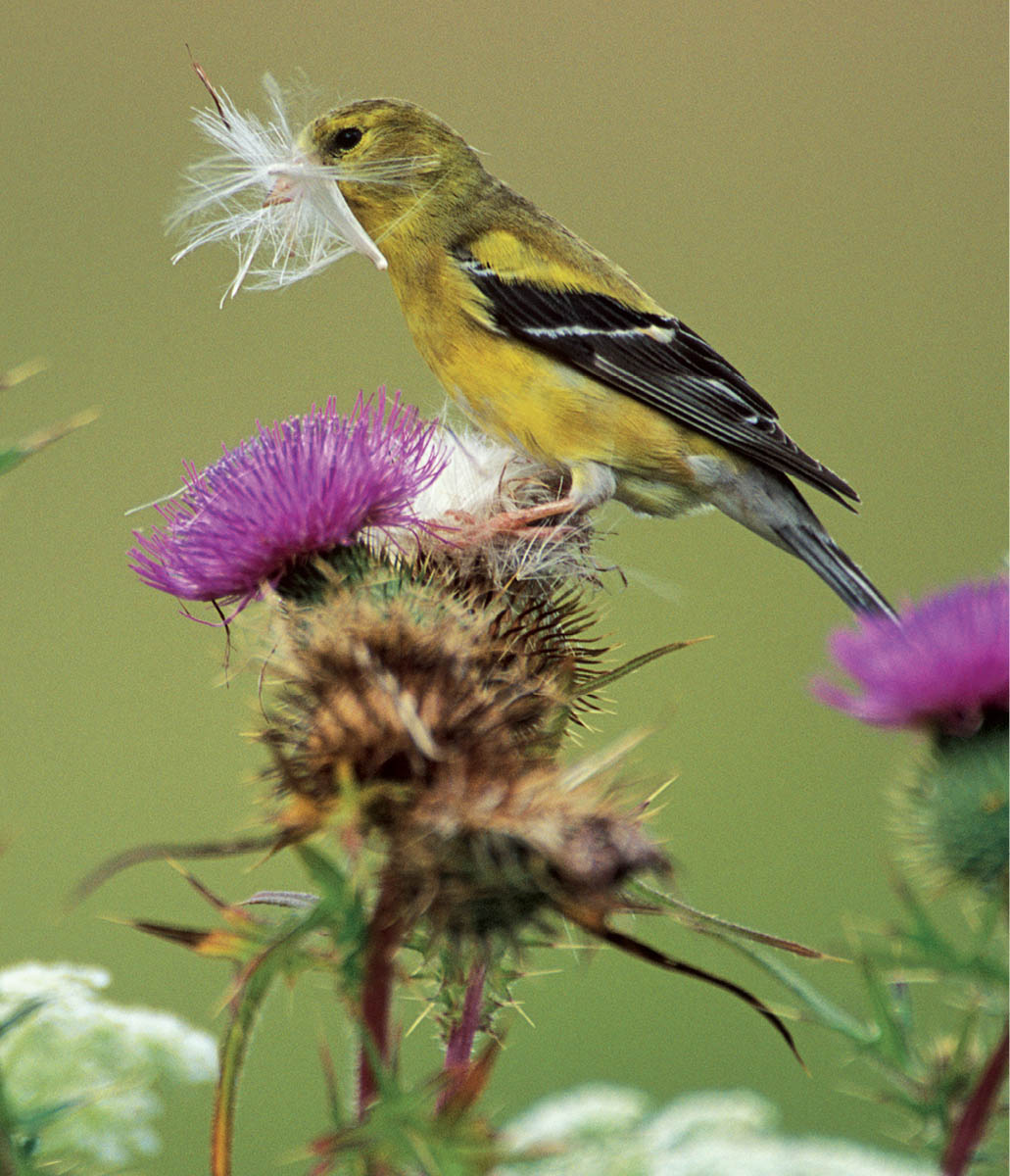
An American Goldfinch female gathers thistle down to line her nest in late July. The female builds the nest, closely accompanied by her mate as she flies back and forth gathering grasses, rootlets, and other fine plant fibers.
Displaying males arrive on the nesting territories about two weeks before females do. Males then engage in butterfly flight displays, singing while circling with slow, deep, exaggerated wing beats. As with prairie-chickens, this may draw females to a common area to choose among competing males.
Although they start singing and chasing in late winter, apparently courting, goldfinches nest late in the season, not copulating or producing eggs until spring has ripened into summer.
The male and female search out a nest location together, but the female makes the final choice. She builds the nest, closely guarded by her mate, making a dense, compact cup, lashing it to the supporting twigs with spiderwebs, and lining it with down from the seeds of thistle, dandelion, cattail, or other soft materials. The process takes about six days.
The pair copulates frequently during the egg-laying period. Eggs hatch 12 to 14 days after being laid, depending on weather conditions and the female’s level of experience. She sits tight while incubating — sleeping, preening, and shifting positions, but remaining on the eggs for up to 90 minutes at a time. The male feeds her on the nest. As he approaches, she makes a high, trilling call; she crouches and flutters her wings, and he regurgitates the goldfinch version of a romantic meal.
Goldfinches construct their nest from fibers of several weed seeds, especially milkweed and thistle, which also produce the bulk of the food they feed their young. These materials aren’t available until summer, so goldfinches must delay nesting far longer than most songbirds. Unlike nearly all American songbirds, goldfinches molt twice a year, their brilliant yellow and black plumage coming in during late winter. Molting depletes energy, so the late molt may also explain the goldfinch’s late nesting.
Newly hatched goldfinches have just a few wisps of pale gray down on the tops of their heads and bodies. Slits in their closed eyelids develop when they’re about three days old; the eyes are completely open within a week. They cannot see their parents at first, but when they feel the slightest vibration at the nest, they instantly pop up and open their capacious mouths while making soft, high-pitched begging calls. At first the male continues to feed the female, and she in turn feeds the nestlings, but within about four days, both parents are sharing duties.
New hatchlings divide their time between sleeping in a crouched position and popping up to gape for food. After they swallow a meal, they poop while a parent is still present to remove it, and then crouch back down. In about a week the chicks grow more active and call more insistently. As they grow more coordinated and curious, they look about, preen, stretch, and back up to poop along the nest rim.
At this point, if an intruder frightens them, they may all flutter to the ground at once. Occasionally some make it to a sheltering shrub, but usually they aren’t ready to survive nest departure until they’re about 12 days old.
Clutch. An American Goldfinch nest with five eggs. The nest is placed in a fork of a shrub or small tree, usually in fairly open habitat such as an abandoned field or hedgerow.
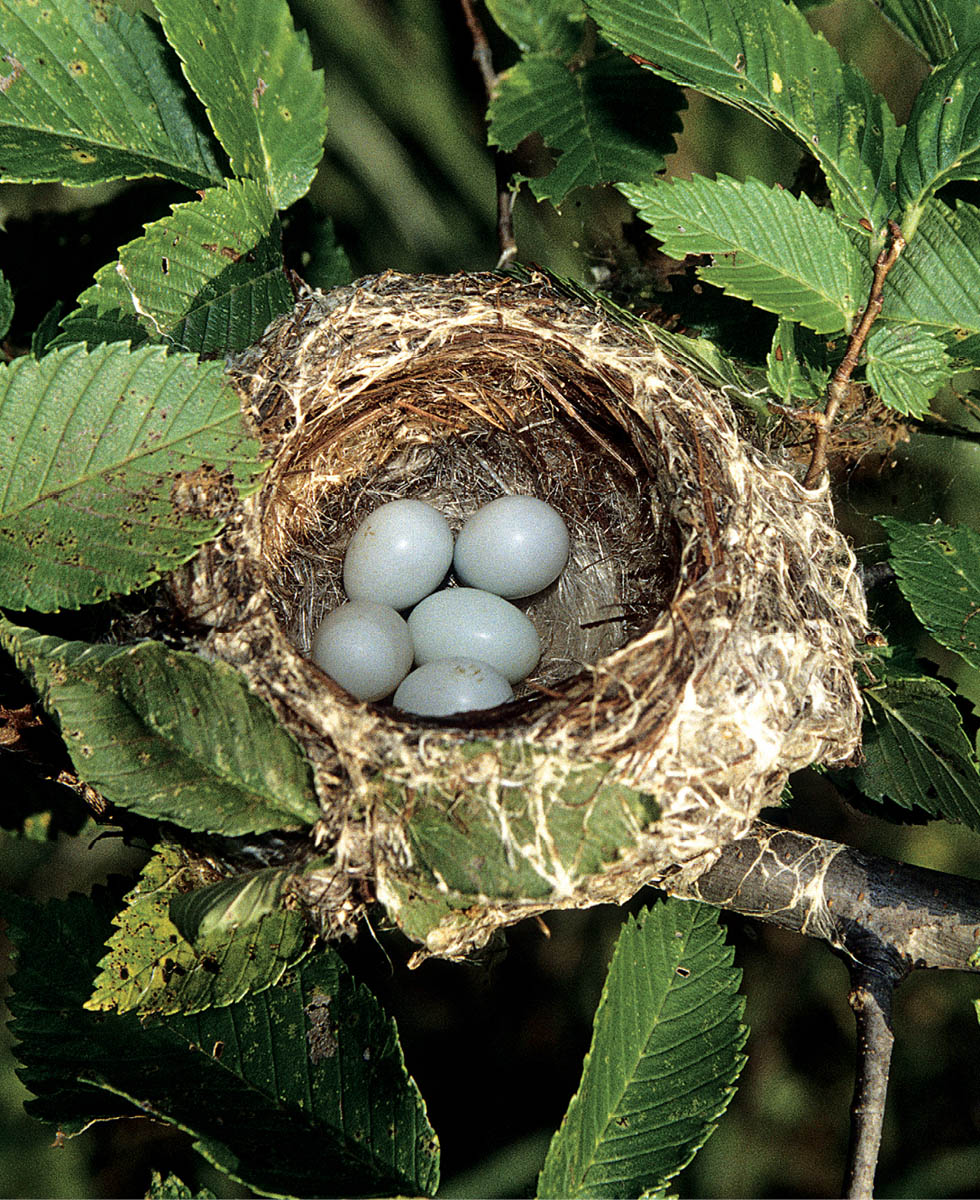
Incubation. The female incubates in her nest, surrounded by honeysuckle berries, in late July. It will take 12 to 14 days for the eggs to hatch.
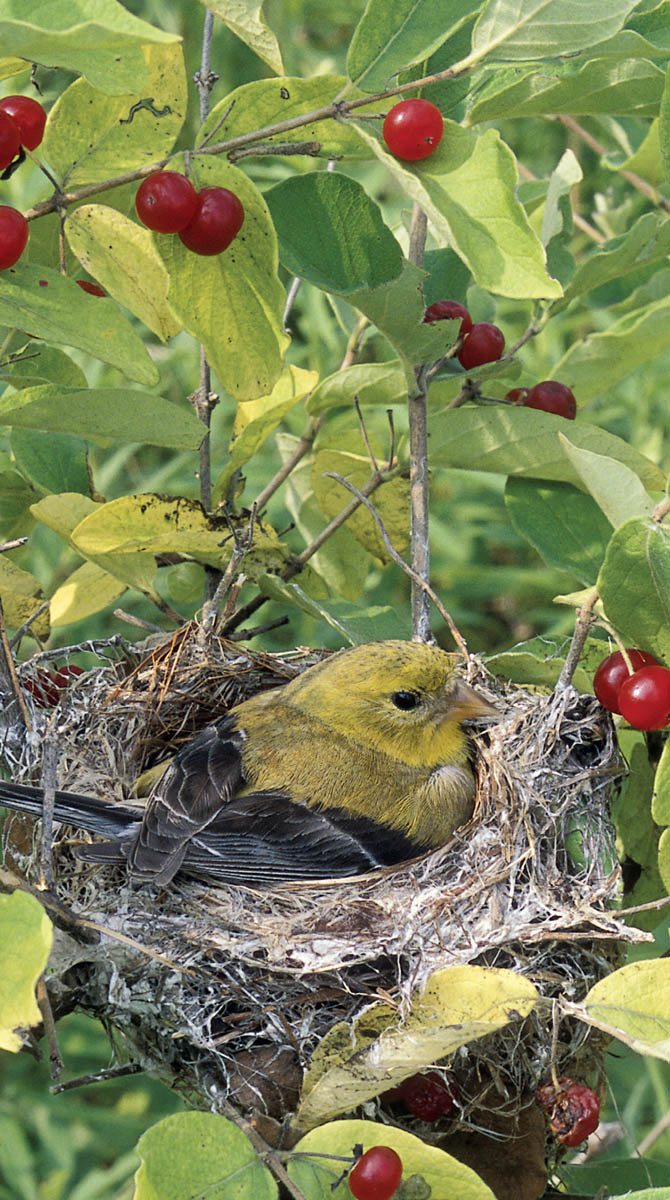
Breakfast. An incubating female American Goldfinch calls a high-pitched trill, tee-tee-tee-tee, as her mate arrives to feed her.

a few days old. Goldfinch nestlings beg from their mother. For the first few days after hatching, the mother broods them closely while her mate brings all the food. But as the nestlings grow in size and appetite, both parents must feed them.
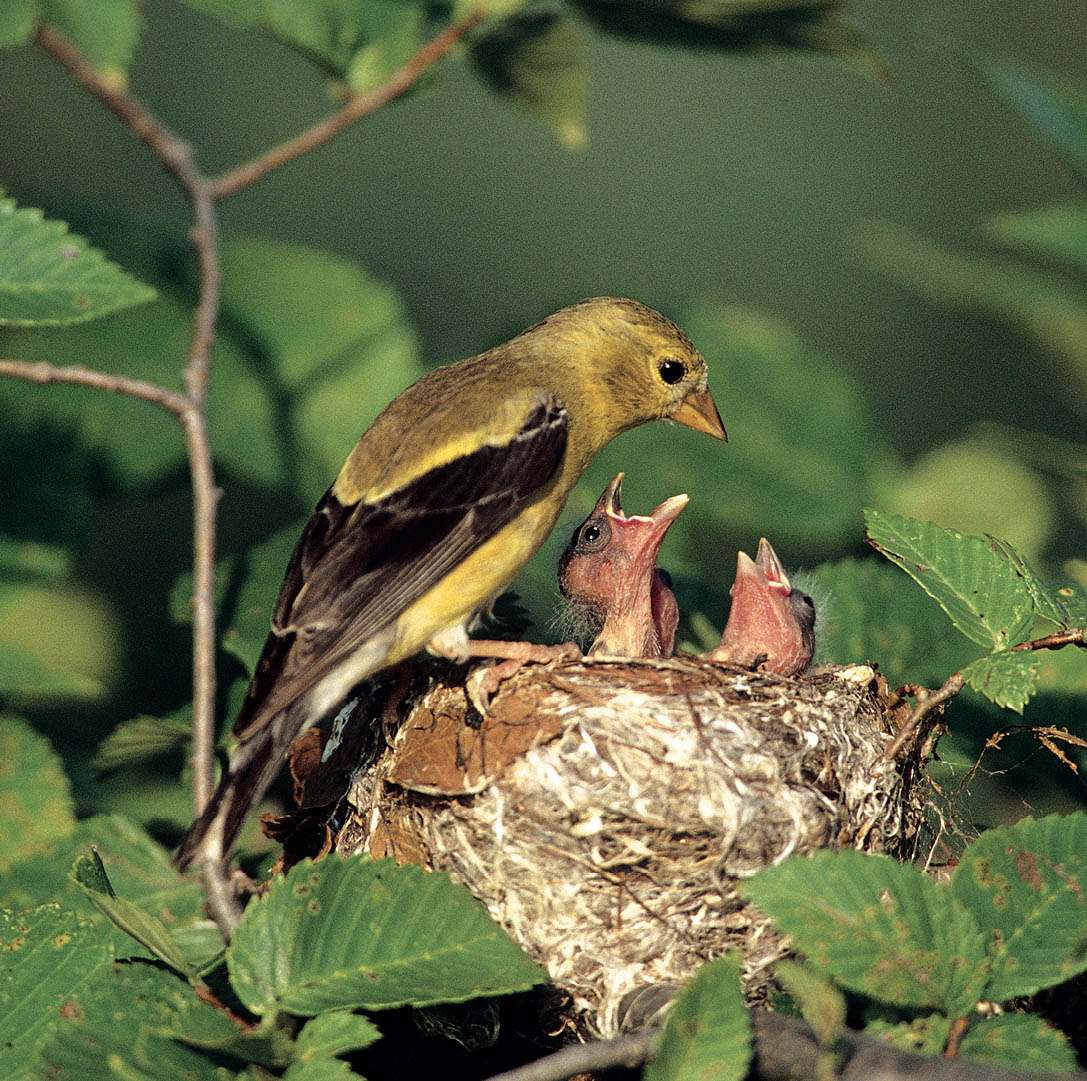
10–12 days old. A male goldfinch perches above his nest with seeds for the begging nestlings. If undisturbed, the young birds may stay in the nest another week. By now, the parents no longer remove the nestlings’ droppings, which accumulate around the rim of the nest.
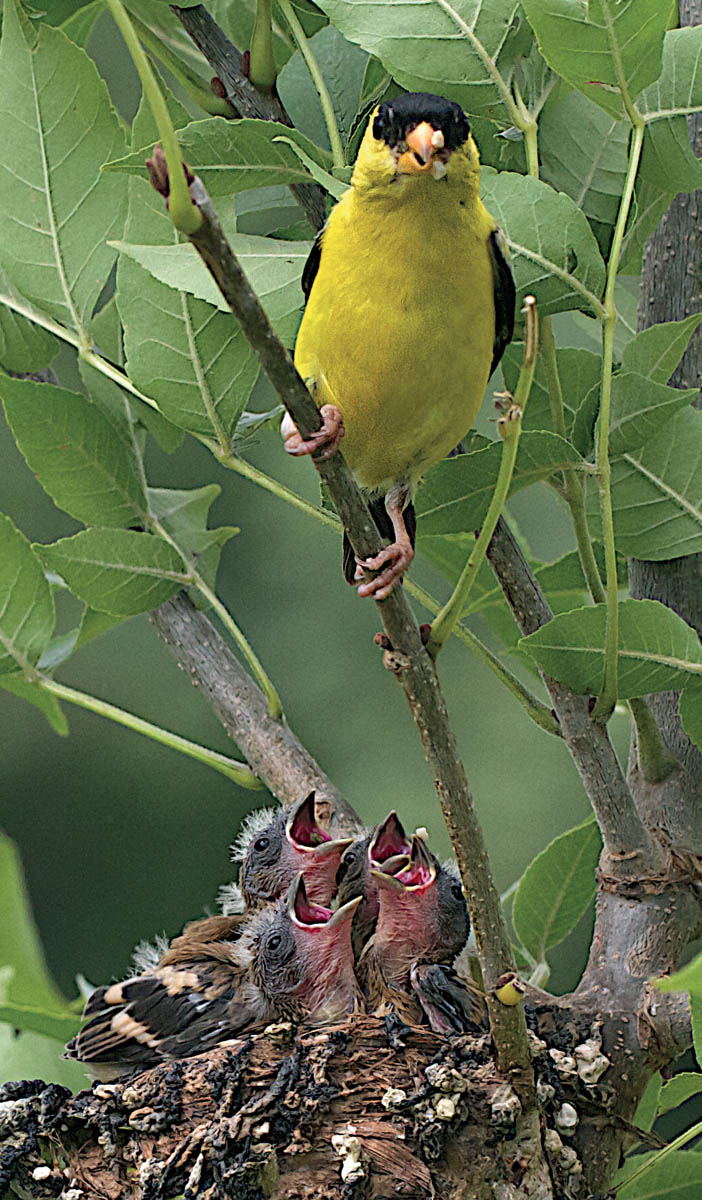
By the time goldfinches start nesting, most cowbirds have finished laying eggs. A cowbird hatchling won’t survive long in a goldfinch nest because it requires much more protein than goldfinches provide. Sadly, newly hatched cowbirds are so voracious that if one does hatch in a goldfinch nest, it gets the lion’s share of the feedings until it succumbs; by then, most or all of the goldfinches in that nest have died, too.
Parent goldfinches feed their young by regurgitating semi-digested seeds in a slurry the consistency of cake batter, strained baby food, or soft cookie dough, the texture changing as the young birds grow more capable. An emergence of mayflies or other event that makes insects especially abundant may lead goldfinch parents to supplement their feedings with insects, but seeds are the primary diet.
Fledgling goldfinches remain dependent on their parents for about three weeks. Most goldfinch pairs produce only one brood per season, but experienced females sometimes re-nest soon after their first brood fledges, leaving childcare of the first brood to the fathers as they find a new mate for the second. Because there are significantly more male than female goldfinches, finding a new mate is fairly simple for the females.
Within a few days of leaving the nest, chicks start to pick up food items, and within a couple of weeks are foraging successfully. They gravitate to other goldfinches, and soon are associating with other juveniles and adults in flocks. As more fledglings join them and more and more adults complete their own nesting cycles, the flocks grow larger.
Goldfinches are will-o-the-wisps in the bird world — abundant in one area one winter and completely absent the next. Birds with such unpredictable migratory behaviors are called irruptive. Even in dull winter plumage, any day with goldfinches at our feeders feels golden, indeed. In early spring, as brilliant feathers start emerging through dull plumage, we are assured that new goldfinches will soon be arriving on this lovely little planet we all call home.

An American Goldfinch fledgling flutters its wings, begging to be fed by its father at a sunflower. Goldfinch fledglings follow their parents to feeding areas, including backyard bird feeders, giving relentless begging calls that sound like chup-ee, chup-ee.
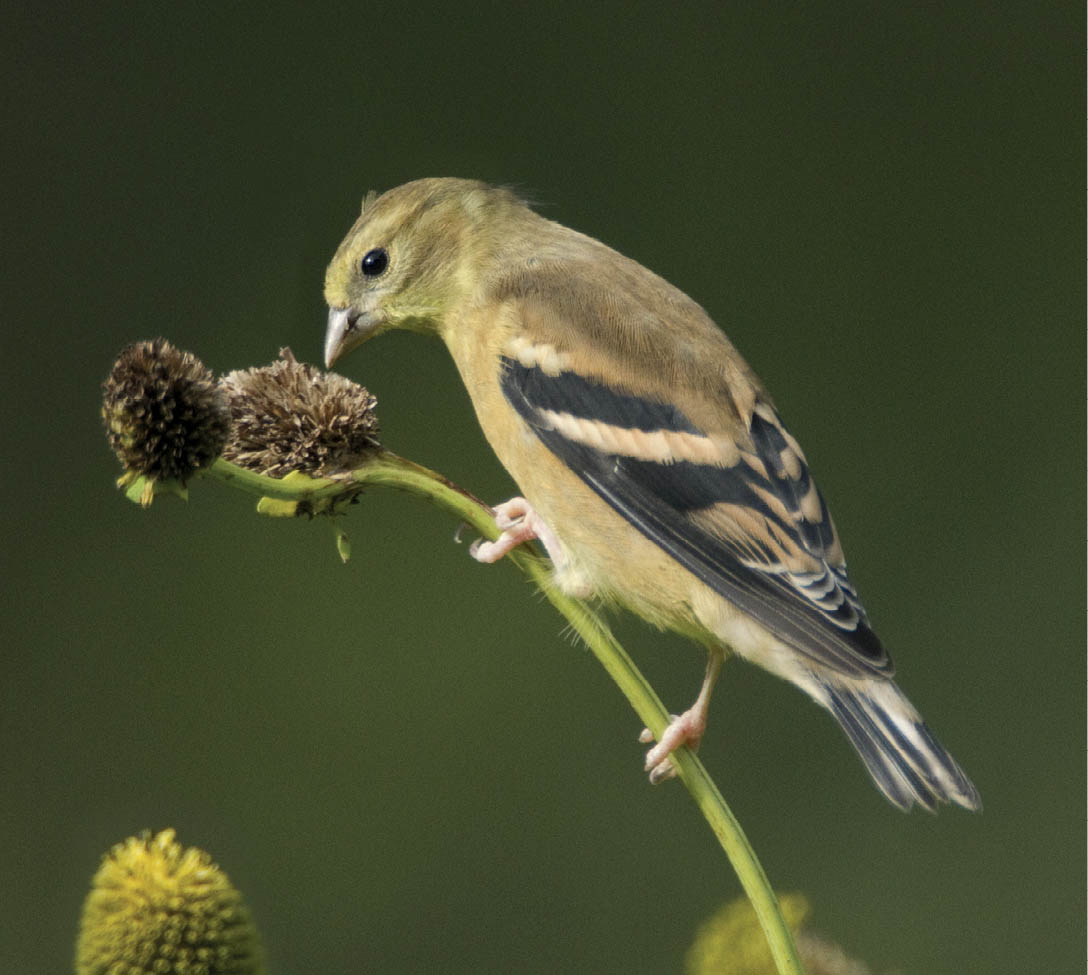
A juvenile American Goldfinch feeds at a seed head of cutleaf coneflower. Buff rather than white wing bars, and some telltale wisps of down on its head, identify it as a juvenile. Within a week of fledging, young goldfinches start pecking and probing at spent flower heads and weeds gone to seed, gradually foraging entirely on their own.